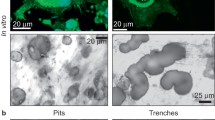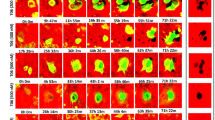Abstract
We hypothesized that newly formed osteoclasts from patients with acute Charcot osteoarthropathy can resorb surfaces of bone more extensively compared with controls. Peripheral blood monocytes, isolated from eight Charcot patients and nine controls, were cultured in vitro on 24-well plates and bovine bone discs in duplicate with macrophage colony-stimulating factor (M-CSF) and receptor activator of nuclear factor κβ ligand (RANKL). Osteoclast formation was assessed by tartrate-resistant acid phosphatase staining (TRAcP) at day 17. Resorption was measured at day 21 after toluidine blue staining by two methods: (1) area of resorption at the surface by image analysis (%) and (2) area of resorption under the surface (μm2) measured by a Dektak 150 Surface Profiler. Ten 1,000 μm-long scans were performed per disc. Pits were classified as unidented, bidented, and multidented according to their shape. Although the number of newly formed TRAcP positive multinucleated cells (>3 nuclei) was similar in M-CSF + RANKL-treated cultures between controls and Charcot patients, the latter exhibited increased resorbing activity. The area of resorption on the surface by image analysis was significantly greater in Charcot patients compared with controls (21.1 % [14.5–26.2] vs. 40.8 % [35.4–46.0], median [25–75th percentile], p < 0.01), as was the area of resorption under the surface (2.7 μm2 [1.6–3.9] vs. 8.3 μm2 [5.6–10.6], p < 0.01) after profilometry. In Charcot patients pits were deeper and wider and more frequently presented as multidented pits. This application of the Dektak 150 Surface Profiler revealed novel differences in resorption pit profile from osteoclasts derived from Charcot patients compared with controls. Resorption in Charcot patients was mediated by highly aggressive newly formed osteoclasts from monocytes eroding large and deep areas of bone.




Similar content being viewed by others
References
Petrova NL, Edmonds ME (2008) Charcot neuro-osteoarthropathy—current standards. Diabetes Metab Res Rev 24(1):S58–S61
Jeffcoate WJ (2005) Theories concerning the pathogenesis of the acute Charcot foot suggest future therapy. Curr Diabetes Rep 5:430–435
Teitelbaum SL (2000) Bone resorption by osteoclasts. Science 289:1504–1508
Fujikawa Y, Quinn JM, Sabokbar A, McGee JO, Athanasou NA (1996) The human osteoclast precursor circulates in the monocyte fraction. Endocrinology 137:4058–4060
Yasuda H, Shima N, Nakagawa N, Yamaguchi K, Kinosaki M, Mochizuki S, Tomoyasu A, Yano K, Goto M, Murakami A, Tsuda E, Morinaga T, Higashio K, Udagawa N, Takahashi N, Suda T (1998) Osteoclast differentiation factor is a ligand for osteoprotegerin/osteoclastogenesis-inhibitory factor and is identical to TRANCE/RANKL. Proc Natl Acad Sci USA 95:3597–3602
Tanaka S, Takahashi N, Udagawa N, Tamura T, Akatsu T, Stanley ER, Kurokawa T, Suda T (1993) Macrophage colony-stimulating factor is indispensable for both proliferation and differentiation of osteoclast progenitors. J Clin Invest 91:257–263
Henriksen K, Bollerslev J, Everts V, Karsdal MA (2011) Osteoclast activity and subtypes as a function of physiology and pathology—implications for future treatments of osteoporosis. Endocr Rev 32:31–63
Teitelbaum SL (2007) Osteoclasts: what do they do and how do they do it? Am J Pathol 170:427–435
Husheem M, Nyman JK, Vääräniemi J, Vaananen HK, Hentunen TA (2005) Characterization of circulating human osteoclast progenitors: development of in vitro resorption assay. Calcif Tissue Int 76:222–230
Mabilleau G, Petrova NL, Edmonds ME, Sabokbar A (2008) Increased osteoclastic activity in acute Charcot’s osteoarthropathy: the role of receptor activator of nuclear factor–kappaB ligand. Diabetologia 51:1035–1040
Fuller K, Murphy C, Kirstein B, Fox SW, Chambers TJ (2002) TNFα potently activates osteoclasts, through a direct action independent of and strongly synergistic with RANKL. Endocrinology 143:1108–1118
Soysa NS, Alles N, Aoki K, Ohya K (2009) Three-dimensional characterization of osteoclast bone-resorbing activity in the resorption lacunae. J Med Dent Sci 56:107–112
Pascaretti-Grizon F, Mabilleau G, Basle MF, Chappard D (2011) Measurement by vertical scanning profilometry of resorption volume and lacunae depth caused by osteoclasts on dentine slices. J Microsc 241:147–152
Asagiri M, Hirai T, Kunigami T, Kamano S, Gober HJ, Okamoto K, Nishikawa K, Latz E, Golenbock DT, Aoki K, Ohya K, Imai Y, Morishita Y, Miyazono K, Kato S, Saftig P, Takayanagi H (2008) Cathepsin K-dependent toll-like receptor 9 signaling revealed in experimental arthritis. Science 319:624–627
Parikka V, Lehenkari P, Sassi ML, Halleen J, Risteli J, Härkönen P, Väänänen HK (2001) Estrogen reduces the depth of resorption pits by disturbing the organic bone matrix degradation activity of mature osteoclasts. Endocrinology 142:5371–5378
Soe K, Delaisse JM (2010) Glucocorticoids maintain human osteoclasts in the active mode of their resorption cycle. J Bone Miner Res 25:2184–2192
Goff MG, Slyfield CR, Kummari SR, Tkachenko EV, Fischer SE, Yi YH, Jekir MG, Keaveny TM, Hernandez CJ (2012) Three-dimensional characterization of resorption cavity size and location in human vertebral trabecular bone. Bone 51:28–37
Jeffcoate WJ, Game F, Cavanagh PR (2005) The role of proinflammatory cytokines in the cause of neuropathic osteoarthropathy (acute Charcot foot) in diabetes. Lancet 366:2058–2061
Uccioli L, Sinistro A, Almerighi C, Ciaprini C, Cavazza A, Giurato L, Ruotolo V, Spasaro F, Vainieri E, Rocchi G, Bergamini A (2010) Proinflammatory modulation of the surface and cytokine phenotype of monocytes in patients with acute Charcot foot. Diabetes Care 33:350–355
McGowan NW, Walker EJ, Macpherson H, Ralston SH, Helfrich MH (2001) Cytokine-activated endothelium recruits osteoclast precursors. Endocrinology 142:1678–1681
Acknowledgments
Supported in part by Diabetes Research and Wellness Foundation. NLP is a holder of a Diabetes Research and Wellness Foundation Clinical Fellowship.
Author information
Authors and Affiliations
Corresponding author
Additional information
The authors report that they have no conflict of interest.
Rights and permissions
About this article
Cite this article
Petrova, N.L., Petrov, P.K., Edmonds, M.E. et al. Novel Use of a Dektak 150 Surface Profiler Unmasks Differences in Resorption Pit Profiles Between Control and Charcot Patient Osteoclasts. Calcif Tissue Int 94, 403–411 (2014). https://doi.org/10.1007/s00223-013-9820-9
Received:
Accepted:
Published:
Issue Date:
DOI: https://doi.org/10.1007/s00223-013-9820-9




